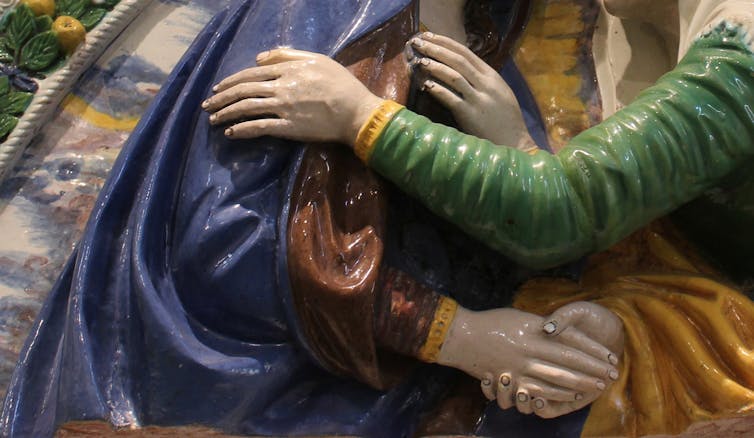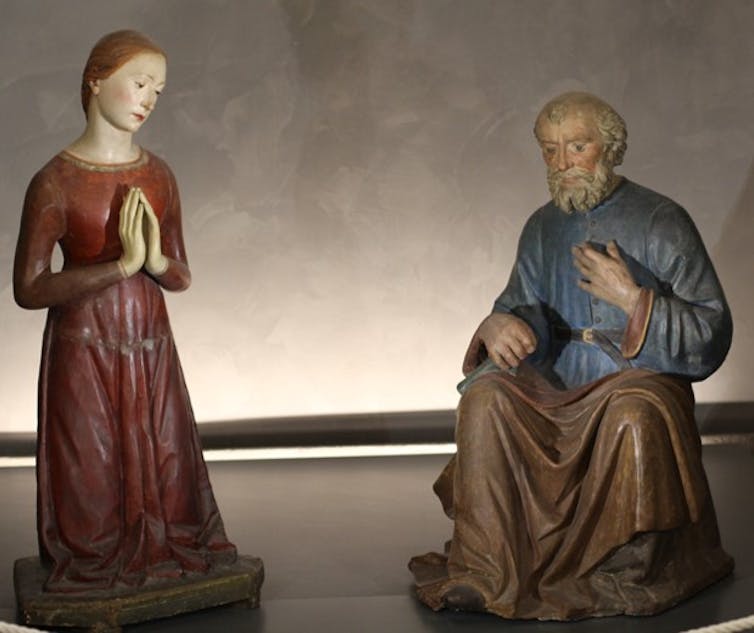The Conversation
Belief in touch as salvation was stronger than fear of contagion in the Italian Renaissance
July 21, 2021
Share

In , even though people understood that a plague ravaging the area was contagious. Devotees travelled from town to town and carried a crucifix — a sculpture of Jesus on the cross — which the crowd longed to touch.
 Authorities tried to ban the group but had to bow to public pressure. A exclaimed, “Blessed is he who can touch it!” Those who could not reach the sculpture pelted it with offerings, including candles, so that these objects could touch it by proxy.
Authorities tried to ban the group but had to bow to public pressure. A exclaimed, “Blessed is he who can touch it!” Those who could not reach the sculpture pelted it with offerings, including candles, so that these objects could touch it by proxy.
That year, in the midst of a plague, often hundreds of people gathered and fought to . The belief in touch as salvation was stronger than the fear of contagion.
As we are all too aware now, after over a year of social distancing due to COVID-19, touch was and is a much-desired privilege. In the Italian Renaissance, people longed to touch not only each other, but also religious sculptures — touch was a form of devotion.
Accessing the sacred
Renaissance Italy was home to and , as well as Christians.
For Christians in the Renaissance, , and so touching them was a way to access the sacred. The cult of relics illustrates this. Relics are physical remains of a saint, either of the saint’s body (such as bones) or of something the saint touched.
These holy physical things are housed in reliquaries, containers to protect and display relics. In the Italian Renaissance, reliquaries took the form of that seemed to bring the saint back to life.
Pilgrims travelled sometimes hundreds of miles on foot to reach these relics — and, for those who could afford it, buy a “contact relic,” which was made by submerging the relic in oil and then dipping a cloth into that oil. By touching that cloth, perhaps wearing it as a talisman, the believer was a part of a chain of physical contact that led to the divine.
Others touched reliquaries. A relic of St. Anastasia is embedded in a glass covered receptacle buried in the chest of a lively, blushing , so that the faithful could see it. The lucky few could reach forward and touch the jewel-like container, as the martyr would seem to look with heavily lidded eyes, almost bemused at this rather intimate gesture.
Sculptures with joints
People also longed to touch sculptures that did not have relics, including life-sized crucifixes, which in the Renaissance were sculptures of a , whose body is covered only by a small loincloth. Before Michelangelo, crucifixes were the public nudes in Renaissance cities. Many crucifixes hung high in churches, and describe saints miraculously elevated, so that they could embrace and kiss the sculpted body of Christ.
Some sculptures in the shoulders, so that at the annual commemoration of Christ’s death (on Good Friday) devotees could take part in a sacred drama, in which the figure of Christ was taken down from the cross and mourned, wrapped in a shroud and placed in a tomb.
During , a lucky few believers could embrace and kiss the sculpture and feel as if they had the ultimate privilege of touching Jesus’ body, reciting : “I, a sinner, am not worthy to touch you.”
In the home
Wealthy families had sculptures that they could , such as , which often have feet worn down by repeated touch so that the toes are barely visible.
Young women getting married or becoming nuns were given painted wooden life-sized or another infant saint, which they would tend as if they were real infants, dressing them in luxurious clothing.
told women to imagine that they were fondling baby Jesus.
Anyone who could afford it would have an image of the . These place , as Mary and Jesus’ limbs are gently intertwined.
But wealthy parents rarely touched their children – infants were sent away to live with a until about the age of three, and on child rearing warned parents not to embrace their children when they returned home. So, in some cases, mothers may have touched sculptures of babies more than they touched their own children.
Interacting with sculptures
Though devotional touch was a privilege for the wealthy, practices of interacting with sculptures as if they were bodies of flesh and blood cut across social classes.
A of the Virgin Mary and her husband Joseph watched over a stone crib at Florence’s orphanage, the . Abandoned infants were placed temporarily in the care of these sculpted parents.

The figure of Mary was sculpted only with a simple red under dress, with no cloak or veil, and so was likely in fabric clothing, probably donated by a local woman. Women would have also this sculpture and others like it as an act of devotion, as it would be scandalous to have a man be so intimate with a sculpture of the Virgin Mary.
Sculpted bodies inhabited cities
Sculpted bodies inhabited Renaissance cities along with living people, filling Renaissance churches, watching over the streets and gracing the bedrooms of even moderately wealthy patricians.
In a society that was ambivalent about the proprieties of touching living flesh, touching sculpted bodies could offer comfort or even salvation.
Renaissance philosophers and clergymen and that supposedly weak-minded women and children were more in need of such physical aids in their devotions than educated men.
But ultimately, touching art was a privilege, a way of touching the divine.![]()
, Professor, Art History and Art Conservation, .
This article is republished from under a Creative Commons license. Read the .
The Conversation is seeking new academic contributors. Researchers wishing to write articles should contact Melinda Knox, Associate Director, Research Profile and Initiatives, at knoxm@queensu.ca.



